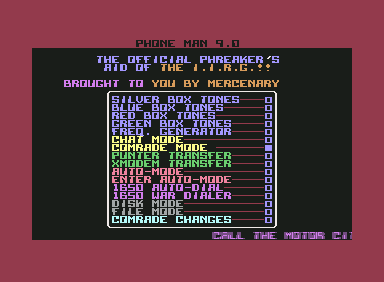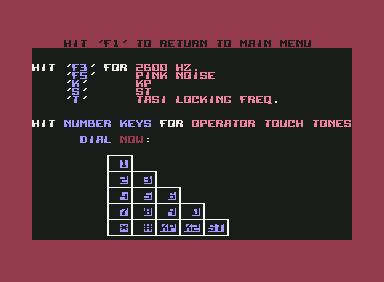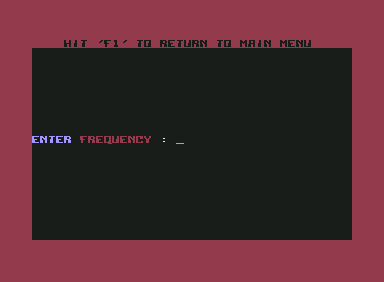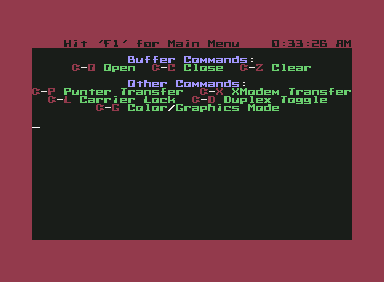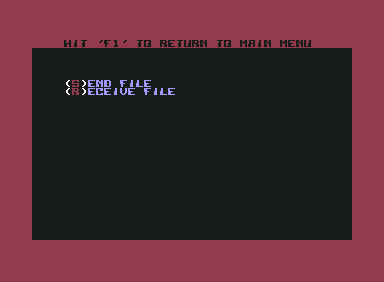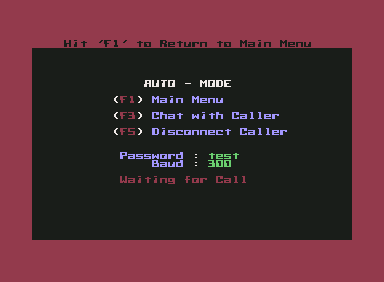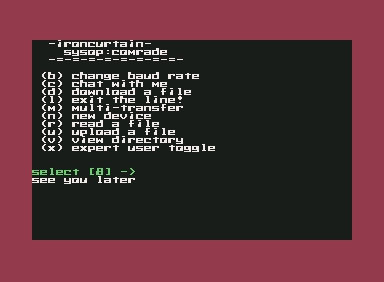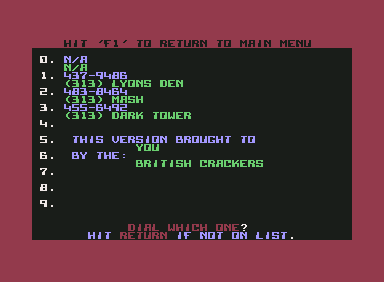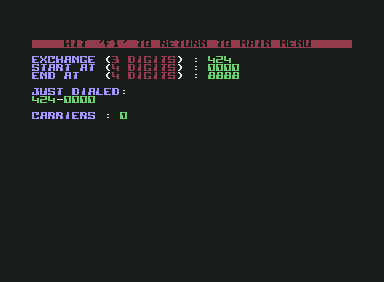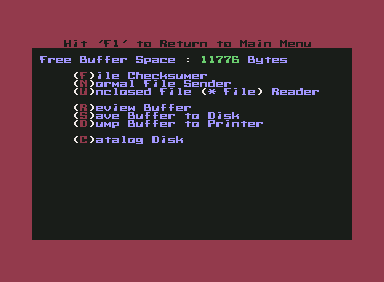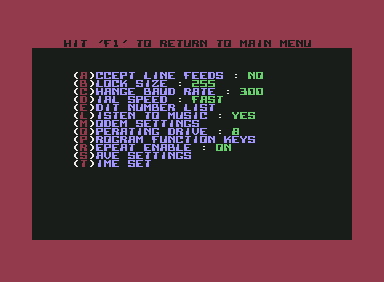.: review number one: phoneman for the c64/128 :.
by root on Dec.30, 2009, under Apps, OldsCool, OldWarez, Telco
Well I put this blog up to be a site for those of us who are melancholy over the old school underground with an emphasis on the applications we used on 8/16 bit computers but so far I’ve not placed any of the promised reviews of those apps online.
Today that all changes, and I figured I would start things off with what I consider to be one of the best of the best of this breed of utility, Phone Man for the Commodore 64/128.
So without further delay, lets get on with review number one on 8bit underground. Please note that the actual download of this application for emulation will be provided on this sites forums which are located here.
Phone Man in this authors opinion, is the epitome of what an underground app should be.
It loads fast, has an attractive and sensible user interface that includes a little candy while still being clear and concise without a ton of useless graphics or unnecessary sounds going on while sitting at the main menu.
Unfortunately, the latest version of Phone Man I have been able to find is one that appears to have been hex edited by someone other than the original author. As always if you have versions of software other than what are reviewed here, we would certainly love to have them submitted for our archive.
Hex editing aside, from what I can recall from having an original release of this app, the functionality appears to be unchanged.
Most box definitions below come from wikipedia.org.
Phone Man 9.0 Main Menu Options:
Silver Box Tones
A silver box is a modified DTMF keypad that adds the four additional keys used in the now-obsolete autovon phone system. This was usually accomplished with the addition of a toggle switch and a crystal that switched one column of a standard phone keypad into the “fourth column” used in the Autovon system. (These keys were used to set the priority level of a call, and are the red keys in the photo on the right. More information is available in the Autovon article.)
Modern phones with an integrated circuit based DTMF generator can frequently be modified by simply soldering a wire from the 1633hz leg to a switch that toggles between that leg and the 1477hz leg for the rightmost column of keys.
Phone Man reproduces the tones made by the hardware silver box faithfully.
Blue Box Tones
An early phreaking tool, the blue box is an electronic device that simulates a telephone operator‘s dialing console. It functions by replicating the tones used to switch long-distance calls and using them to route the user’s own call, bypassing the normal switching mechanism. The most typical use of a blue box was to place free telephone calls – inversely, the Black Box enabled one to receive calls which were free to the caller. The blue box no longer works in most western nations, as modern switching systems are now digital and no longer use the in-band signaling which the blue box emulates. Instead, signaling occurs on an out-of-band channel which cannot be accessed from the line the caller is using (called Common Channel Interoffice Signaling (CCIS)).
Phone Man reproduces all necessary hardware bluebox tones via the C64/128 sound chip.
Red Box Tones
A red box is a phreaking device that generates tones to simulate inserting coins in pay phones, thus fooling the system into completing free calls. In the US, a dime is represented by two tones, a nickel by one, and a quarter by a set of 5 tones. Any device capable of playing back recorded sounds can potentially be used as a red box. Commonly used devices include modified Radio Shack tone dialers, personal MP3 players, and audio-recording greeting cards.
Phone Man faithfully reproduces the three tones generated by a hardware red box.
Green Box Tones
In Phreaking, the Green box was a device whose function was to manipulate the coin collection mechanism of Payphones. It employed three of the MF (multi-frequency) tones used in the Blue box and could be viewed as a subset of that device.
By overlaying two tones, Phone man is able to reproduce the sounds generated by hardware Green Boxes via software.
Frequency Generator
Exactly what it says it does – the Phone Man frequency generator allows the user to enter a numerical frequency and Phone Man will reproduce it via the C64/128 sound chip.
Chat Mode
The additional features such as a built in Chat Mode are some of the things that lead me to call Phone Man one of the pinnacle softwares for phreaking and trading warez in the 80’s. The Phone Man chat mode section not only facilitates talking with another person via modem, but also has built in transfer capabilities such as xmodem and the commodore specific punter protocol. Color and graphics could also be disabled.
Comrade Mode
This appears to be a hex edited addition to phone man 9.0 which is nothing more than another option to enter chat mode.
Punter Transfer
Commodore specific transfer protocol implemented within Phone Man to facilitate file send and receive.
Xmodem Transfer
XModem file send and receive built into Phone Man.
Auto-Mode
During the early 80’s, Apple Ascii Express hosts began popping up all over NPA’s across America – and the world. Ascii Express was the simple way to allow trading of files to occur, and implemented only a single method of security that involved a single password sign on system. During this time security wasn’t as concerning as was building the largest file library one could – so the single sign on system wasn’t initially a problem until later when “leeches” began to causes problems and things such as post/call and upload/download ratios became the norm.
Auto Mode was an AE system for the c64/128 and is probably the biggest reason that I feel Phone Man wins the award for best h/p/warez app that has ever been written. One could use the blue box to gain access to distant BBS’s or Host Mode’s, transfer files, and then set up the Auto Mode as a mini-bbs allowing others to call and upload and download.
This was a seamless system for the day, and the only way it could have been improved upon would have been to add multiline capabilities so that while uploading and downloading from other BBS’s, callers could still use the host mode.
Enter Auto-Mode
This is what it looked like when you connected to Phone Man while it was running Auto Mode. A simple but completely effective mini-bbs. Who needs messaging when all you care about is warez?
1650 Auto Dial
Simply a built in terminal program.
1650 War Dialer
Based on software that was developed extremely early in the history of computing, and named after the 80’s movie “War Games”, a wardialer allows an individual to program their modem to call number after number in search of a carrier tone (another computer). When that carrier tone is found, the computer makes a note of it to a text file so that the user can later call the number (using Auto Mode for example) and investigate the system. This was often the first step in hacking during the late 70’s and 80’s all the way through to the early 90’s and even – but much less frequently – in modern times.
Disk Mode
Basic disk based commands could be executed from within Phone Man so that the user would not have to exit the program.
File Mode
Basic file based commands could be executed from within Phone Man so that the user would not have to exit the program.
Comrade Changes
I believe the title “comrade changes” is more evidence of the fact that this version of Phone Man was hex edited by someone – but long story short, this section of the program allowed for basic modem and system settings to be configured so that the various modules of the program would work as expected.
In Closing:
I first stumbled across Phone Man when the program was quite mature due to the fact that I “grew up” on using Atari 8-bits – which unfortunately had nothing anywhere close to what Phone Man did bundled into a single program, though it certainly could have.
I had borrowed a c64c and a bluechip disk drive and some warez disks that a friend had. He obviously had an affinity for hacking/phreaking because I found his “phreak disk” which contained Phone Man as well as many other utilities. I was awestruck when I loaded Phone Man and saw what it was capable, and long dreamed of a similar app being coded for the Atari or for any other system for that matter. Sure, once PC’s became adept at Multi Tasking, there really wasn’t a need to “all in one” programs like this anymore, but by that time a lot of the romance and geek factor had been lost in the hacking and phreaking world – at least to me. The scene had become proliferated with wannabe’s who believed that programs like this MADE them hackers and that just because they had a code to trade that they should be respected and treated the same as those who truly had knowledge.
On a final note, I stumbled across a textfile by a group of Atari phreakers/hackers called The Underground Fone Federation. It was called The Remote Informer, and once I found it I scoured the net to download all issues – of which it appears there are six.
In one of those issues I found the following:
Also be watching for the ProwlPak, a disk that will be soon released
containing a autobootmenu program, from where you can select and run The
Prowler, TeleNet Scanner, or The Theif. Crusader wouldn’t tell us much
about The Theif, but he claimsit will be the greatest code hacker ever
written, with the most features, and the easiest to use. Also be looking
for ARTS, The [A]tari [R]emote [T]rading [S]ystem. It is a small bulletin
board system designed after the Apple AE concept. Mos of his programs can
be found on a good bbs near you, so ask around!
So it is very obvious that least someone had contemplated writing something somewhat similar to Phone Man for the Atari 8-bit. Who knows if it ever saw the light of day or if the source code to a partially written app ever got released. I do know I will be looking for it in the piles of disks I am attempting to collect in hopes that it did.
Thanks for taking the time to read this first review – and if you have anything to add please feel free to contact me.

